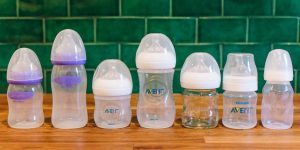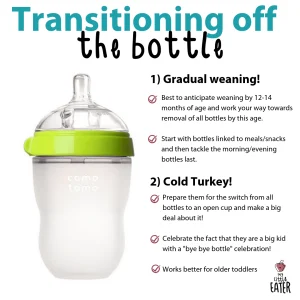A formula feeding guide provides accurate instructions on how to feed infants using formula milk. This article provides a comprehensive overview of how to correctly prepare and store formula, as well as tips for ensuring proper nutrition for the baby’s overall growth and development.
It also highlights important considerations such as choosing the right formula, adjusting feeding amounts as the baby grows, and addressing common challenges that parents may encounter. By following this guide, parents can confidently meet their baby’s nutritional needs while bottle-feeding, ensuring their health and well-being.
Choosing The Right Formula Feeding Guide
Finding the right formula for your baby can be overwhelming, especially with the wide range of options available in the market. It’s important to choose a formula that meets your baby’s nutritional needs and suits their specific dietary requirements. In this section, we will discuss the different types of formula and give considerations for babies with specific dietary needs.
Understanding Different Types Of Formula
When it comes to formula feeding, there are three main types of formula available: cow’s milk-based formula, soy-based formula, and hypoallergenic formula. Each type has its own unique qualities and advantages, so it’s essential to understand the differences to make an informed decision.
1. Cow’s Milk-Based Formula:
Cow’s milk-based formula is the most commonly used type of formula. It is designed to mimic breast milk as closely as possible, providing the necessary nutrients for your baby’s growth and development. This type of formula is suitable for the majority of babies and is a good choice if your baby has no specific dietary restrictions or allergies.
2. Soy-Based Formula:
If your baby is allergic to cow’s milk protein or lactose intolerant, soy-based formula can be a suitable alternative. Soy-based formula is made from soybeans and is lactose-free. It provides the necessary nutrients for your baby but note that some babies may be allergic to soy as well. It is important to consult with a pediatrician before switching to soy-based formula.
3. Hypoallergenic Formula:
Hypoallergenic formula is specially formulated for babies with allergies or intolerances to cow’s milk protein or soy. It is highly digestible and contains proteins that are broken down into smaller particles, making it easier for babies to tolerate. Hypoallergenic formulas can be further classified into two types: extensively hydrolyzed formulas and amino acid-based formulas. Extensively hydrolyzed formula contains proteins that have been partially broken down, while amino acid-based formula contains individual amino acids. These formulas are recommended for babies with severe allergies or gastrointestinal issues.
Considerations For Specific Dietary Needs
Babies with specific dietary needs require special attention when choosing the right formula. Here are some considerations to keep in mind:
- If your baby has acid reflux or spit-up issues, look for a formula that is specially formulated to reduce reflux symptoms.
- For babies with lactose intolerance, lactose-free formulas or soy-based formulas can be suitable alternatives.
- If your baby has a cow’s milk protein allergy, consider hypoallergenic formulas that are free from cow’s milk protein.
- Babies with a family history of allergies or eczema might benefit from hydrolyzed protein formulas.
- For premature babies or those with low birth weight, specialized formulas with higher calories and nutrients may be recommended.
Remember, it’s always best to consult with your pediatrician before making any changes to your baby’s feeding routine. They can provide personalized guidance based on your baby’s individual needs and help you choose the right formula for your little one.

Effective Formula Feeding Techniques
Learn effective formula-feeding techniques with this comprehensive guide. Discover essential tips and strategies for successful formula feeding, ensuring the health and well-being of your little one.
Proper Bottle Preparation And Sterilization
Proper bottle preparation and sterilization are essential aspects of effective formula feeding. It is crucial to ensure that your baby’s feeding equipment is clean, sanitized, and safe to use. Follow these steps to guarantee optimal hygiene: 1. Thoroughly clean: Before each use, wash the bottles, nipple, and any additional feeding accessories, such as rings or caps, with warm soapy water. Use a bottle brush to reach all areas, rinsing away all residue. 2. Sterilize: Once cleaned, sterilize the bottles and nipples to eliminate bacteria. There are various methods you can use, including: a) Boiling: Submerge the bottles in boiling water for at least 5 minutes. Similarly, boil nipples for 2-5 minutes. Ensure you cover the pot to prevent contamination. b) Steam sterilization: Use an electric steam sterilizer or microwave sterilizing bags according to the manufacturer’s instructions. These methods are faster and more convenient. 3. Air-dry and store properly: After sterilization, allow the bottles and accessories to air-dry completely on a clean, dry towel. Once dried, assemble the bottles, securing the nipple and any additional parts.
Feeding Schedules And Portion Sizes
Establishing a feeding schedule and determining adequate portion sizes is crucial for your baby’s well-being. Here are some guidelines to help you create a structured routine: 1. Frequency: Newborns typically require feeding every 2-3 hours, which may eventually stretch to every 3-4 hours as they grow. Ensure your baby receives a minimum of 8 feeds in 24 hours. 2. Portion sizes: The appropriate amount to feed your baby may vary based on their age and weight. Consult your pediatrician for precise recommendations. As a general rule, infants consume 2-3 ounces (60-90 ml) per feeding during the first few weeks. This can gradually increase to 4-6 ounces (120-180 ml) per feeding by the end of the first month. 3. Cue-based feeding: Babies often display their hunger cues, such as increased alertness, lip smacking, or rooting. Respond promptly to these signals and offer her a feeding. Conversely, if your baby shows disinterest or turns away, do not force-feed. Remember, each baby is unique, and their feeding needs may differ. Pay attention to their individual cues and consult with your pediatrician for customized guidance.
Tips For Reducing Colic And Gas
Excessive gas and colic can cause discomfort for your little one. Implementing the following tips can help alleviate these issues: 1. Proper positioning: During feeding, ensure your baby is in an upright, slightly inclined position to reduce the intake of air. Keep her head higher than her stomach to prevent gas accumulation. 2. Burping techniques: Burp your baby after every feeding by gently patting or rubbing her back. This helps release any trapped air, reducing the likelihood of colic or gas. 3. Anti-colic bottles: Consider using anti-colic bottles designed to reduce the entry of air bubbles and minimize feeding-related discomfort. These bottles often feature special vents or design features to prevent excessive air intake. 4. Slow and steady: Encourage your baby to feed at a comfortable pace. Avoid forcing the bottle, as rapid feeding can lead to excessive air swallowing. Allow breaks during the feeding session if needed. By implementing these effective formula-feeding techniques, you can ensure both cleanliness and comfort for your baby throughout their feeding journey. Remember to seek professional advice from your pediatrician for personalized recommendations based on your baby’s needs.
Addressing Common Concerns
Formula feeding is a popular alternative to breastfeeding, providing a convenient and reliable way to ensure your baby receives the essential nutrients they need. However, as with any major decision regarding your child’s health, it’s natural to have some concerns. In this section, we’ll tackle a few of the most common concerns related to formula feeding, providing you with the information and guidelines you need to navigate these situations confidently.
Dealing With Allergies Or Sensitivities
Allergies or sensitivities to certain ingredients in the formula can occur, but rest assured, there are solutions available to address these issues. If you suspect your baby has an allergy or sensitivity, it’s important to consult with your pediatrician first. They can guide you in choosing an appropriate hypoallergenic formula that is specifically designed to minimize the risk of allergic reactions.
Additionally, it’s crucial to carefully read the ingredient labels of the formulas you purchase. Look for formulas that are free of common allergens such as cow’s milk, soy, or lactose. Remember, finding the right formula for your baby’s unique needs may require some trial and error, so be patient and seek professional advice.
Transitioning From Breastfeeding To Formula
When transitioning from breastfeeding to formula, it’s helpful to do so gradually to allow your baby’s digestive system to adjust. Start by substituting one breastfeeding session with a bottle of formula, and gradually increase the number of formula feeds over time. This slow transition can help prevent discomfort for both you and your baby.
Some babies may resist the change initially, especially if they have become accustomed to breastfeeding. During this period, offering your baby plenty of love and reassurance can help them adjust to the new feeding routine. Remember, every baby adapts differently, so give your little one time and a supportive environment to make the transition smoothly.
Introducing Solid Foods Alongside Formula
As your baby grows, their nutritional needs will evolve, and it becomes time to introduce solid foods alongside their formula. According to the American Academy of Pediatrics, it’s generally recommended to start introducing solid foods around six months of age, in addition to continued formula feeding or breastfeeding.
Initially, solid foods should complement rather than replace formula feeds. Begin with simple, pureed foods such as mashed fruits or vegetables, and gradually introduce a wider variety of textures and flavors as your baby becomes more accustomed to solid foods. Remember to offer solids after a formula feed, as their primary source of nutrition should still come from formula or breast milk.
Overall, introducing solid foods alongside formula provides an opportunity for your baby to explore new tastes and textures while continuing to receive vital nutrients from their formula feeds. As with any feeding transition, it’s important to pay attention to your baby’s cues and consult with your pediatrician for guidance throughout the process.
How Much Formula Should A Baby Drink Chart?
A baby’s Formula Feeding Guide intake can vary, but as a general guideline, a newborn may consume about 1. 5 to 3 ounces of formula per feeding. This amount may increase to approximately 2 to 4 ounces as the baby grows. It’s important to consult with a pediatrician for personalized recommendations.
How Do I Know How Much Formula To Give My Baby?
To determine how much formula to give your baby, consult the feeding guidelines recommended by your pediatrician. It’s based on factors like your baby’s age, weight, and appetite. Following these guidelines will ensure your baby gets the appropriate amount of nutrition.
How Do I Calculate Formula Feeding For My Baby?
To calculate the Formula Feeding Guide for your baby, you can follow this simple equation: baby’s body weight in pounds x 2. 5 ounces of formula per pound of body weight divided by the number of feedings per day. For example, if your baby weighs 10 pounds and feeds six times a day, the calculation would be 10 x 2.
5 / 6 = 4. 17 ounces per feeding. Adjust as needed based on your baby’s age and appetite.
What Is The Ratio For Formula Feeding?
The Formula Feeding Guide ratio for formula feeding depends on various factors such as the age and weight of the baby. It is best to consult with a healthcare professional or refer to the instructions on the formula packaging for specific guidance. The recommended ratio typically ranges from 1 scoop of formula per 2 ounces of water to 1 scoop of formula per 4 ounces of water.
Conclusion
This formula feeding guide provides essential information and tips to help parents navigate the world of infant formula. From understanding different types of formula to preparing and storing it correctly, this guide aims to ensure that babies receive the necessary nutrition for their growth and development.
Remember, always consult with a healthcare professional for personalized advice and guidance. Happy formula feeding!





